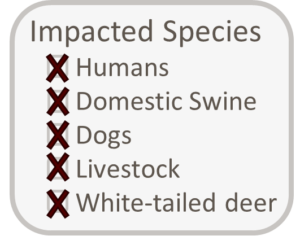Tularemia is a zoonotic disease caused by the bacteria Francisella tularensis. When transmitted to humans, Tularemia is more commonly known as “Rabbit Fever” because rabbits and hares are common hosts. Tularemia can be found throughout the northern hemisphere and has been identified in over 250 animal species. Feral hogs have also been documented carrying the disease and studies in northwest Texas found antibodies present in 15% to 50% of sampled hogs depending on the region. The presence of antibodies in a sample indicates the animal was exposed to the bacteria at some time in the past or currently infected. The disease can also be carried by fleas, ticks, or other arthropods who have bitten an infected individual. Once infected, those parasites can spread the disease to other individuals through their bite. In cattle and sheep, Tularemia can cause fever, weakness, and, if infected from a bite, enlarged lymph nodes near the bite location.

Tularemia infection in human thumb. Photo by AFIP; Center for Food Security and Public Health at Iowa State University, College of Veterinary Medicine
In humans, Tularemia symptoms can range from mild to life threatening depending on how it was transmitted, but all are accompanied by a high fever. If transmitted through a bite from a flea or tick, an ulcer will form, and lymph nodes will swell near that location. If transmitted through bacterial contact with eyes (typically associated with butchering), inflammation of the eyes and swelling of lymph nodes near ears will occur. If the transmission occurs through eating or drinking contaminated food or water, Tularemia can cause sore throat, mouth ulcers, tonsillitis, and swelling on neck lymph nodes. The most serious symptoms of Tularemia occur when the transmission occurs through inhalation and the bacteria moves directly to the lungs. This form of transmission results in cough, chest pain, and difficulty breathing.
